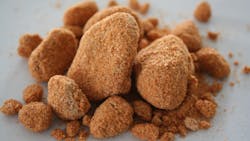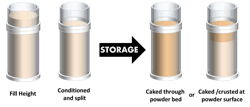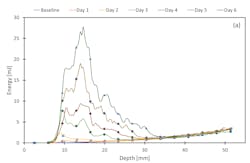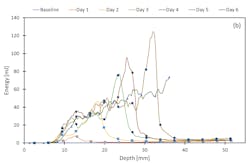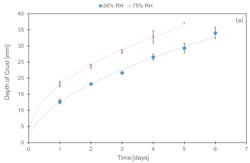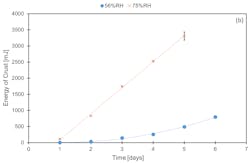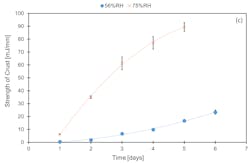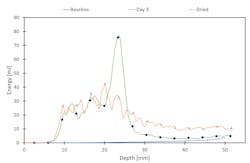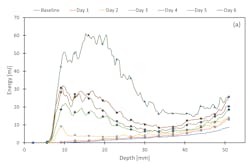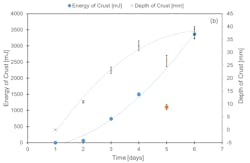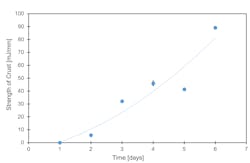Caking and crusting: Test methods for the development of optimal powder storage and handling strategies
Many powders have a tendency to cake during storage. As the strength of particle-particle interactions increases, especially via mechanisms involving moisture, the flow characteristics of the material are compromised detrimentally, impacting both performance and value. Caking may be preventable or easily addressed through the adoption of well-defined protocols, by storing the material in a closely controlled environment, or by periodically inducing flow through the use of low volume recycling loops. However, these strategies typically involve inconvenience and cost. Making sensible, cost-effective decisions for combating caking relies in the first instance on being able to quantify the sensitivity of a powder in this regard and identifying the most influential factors.
In this article, we demonstrate the unique value of using dynamic powder testing to elucidate caking mechanisms. A particular focus is crusting, the heterogeneous development of caked material at an exposed surface, rather than throughout the material. Experimental data illustrate the contrasting behavior of routinely used excipients and ingredients and demonstrate how appropriate testing can support the optimization of powder storage and associated handling.
The mechanisms of caking
Many raw materials and products in the food, chemical and pharmaceutical processing industries are supplied as relatively free-flowing powders, and their value is dependent on this characteristic. For logistical reasons, these materials are often stored for extended periods, during which time there is potential for interparticle forces to strengthen as a result of prolonged and undisturbed particle/particle contact and interaction with the immediate surroundings. This process is referred to as "caking" and it can significantly limit the ability of a powder to pass through the manufacturing process without interruption, and/or detrimentally impact product quality. Caked material may take a range of forms, from soft, easily broken aggregates to irreversibly fused particles that are no longer representative of the original material and extremely difficult to disperse.
A comprehensive discussion on the mechanisms of caking is provided by Reference 1, but in summary they can be classified as chemical, plastic deformation, electrical and mechanical. Of these, chemical caking is the most common. This is where chemical reactions, such as decomposition, hydration/dehydration, recrystallization and sublimation, typically at the particle surface, create inter-particulate bonding and, ultimately, agglomerates. However, caking mechanisms are not independent of one another with one or more often occurring simultaneously. The absorption and migration of atmospheric water, for example, is frequently associated with softening or plasticization, prior to the fusion (chemical caking) which results in agglomeration.
Quantifying and understanding the caking behavior of a specific powder, and the factors that influence it, is an essential precursor to establishing suitable conditions for storage. Crucial insights include: whether caking occurs homogeneously throughout the powder bulk or just at the powder surface exposed to the environment; any association of caking with the migration of water through the bed; the reversibility of the caking process and the strength of the resulting agglomerates; and how quickly a powder gains unacceptable properties.
Dynamic powder testing — a unique tool for caking studies
Dynamic powder testing quantifies powder flowability from measurements of the axial and rotational forces acting on a blade, or impeller, as it is precisely rotated through a powder sample. The technique was developed to measure powder flowability in support of process development and optimization studies and offers the flexibility to control the test environment to simulate process conditions. It can be used to assess caking behavior under varying environmental conditions and to test consolidated samples.
Due to the way in which dynamic testing is carried out (see Figure 1) flowability can be measured as a function of bed height. The baseline dynamic property is Basic Flowability Energy (BFE), which is measured using a downward traverse of the blade. Data is recorded every 40ms as the blade passes down through the powder bed so the position of the blade within the vessel can be determined with a high degree of accuracy. The resulting values are integrated to provide a total flow energy measurement (as shown in Figure 1) but allow the precise evaluation of any differences in flow characteristics within the sample. This makes the technique uniquely valuable for the study of non-homogeneous caking. With dynamic testing it is possible, for example, to track the impact of moisture migration through a bed, to assess the effect of humidity cycling to determine whether caking is reversible or not and to directly quantify the relative strength of aggregated material developed at any point in the bed.
The following study showcases the use of BFE measurements to elucidate caking and the different types of non-homogeneous caking behavior that are routinely encountered.
Case study: Investigating the non-homogeneous caking behavior of skimmed milk powder and sulfonated methyl ester
Skimmed milk powder (SMP) and sulfonated methyl ester (SME) are industrially important powders widely used in the food and detergent industry, respectively. Tests were carried out using an Freeman Technology FT4 Powder Rheometer to evaluate the flow properties of commercial samples of both of these materials, in the "as received" state, and following exposure to an environment of controlled relative humidity, to compare and contrast moisture induced caking behavior.
"As received" samples of the two materials were tumbled prior to testing, to eliminate segregation, and then conditioned. Conditioning is a primary step in dynamic testing that involves gentle displacement of the sample, using the standard instrument blade, to create a homogenously packed powder bed for subsequent testing. Conditioning eliminates the impact of operator influence and processing history, significantly improving the reproducibility of the technique.
Following the measurement of BFE for the "as received" material using standard test protocols2, samples were stored for periods of up to 13 days, in minimum increments of half a day, at ambient temperature (22-25°C), at different levels of relative humidity (%RH): 53% and 75% RH. Samples removed from storage were immediately re-tested to generate a series of BFE measurements tracking the progress of any caking. Measurements were repeated three times for each condition to confirm the repeatability of the data, using a newly prepared sample each time since testing destroys any caked structure. Storing the samples in the standard cylindrical test vessel replicates the interface at which a powder is exposed to the atmosphere in a typical silo or hopper thereby enabling the investigation of crusting behavior. Figure 2 schematically demonstrates the sample preparation and storage sequence.
Skimmed milk powder
Results for the SMP samples are shown in Figure 3. Storage times were limited to a maximum of six days since longer periods resulted in solidification that made flow energy measurements impossible, notably for the SMP stored at 75% RH for which it was only possible to produce a partial trace for six days storage. For all storage times, at both 53% and 75% RH, peaks are observed in the energy profile. Localized crusting within a powder bed causes a peak in the force and torque required to push the blade through the sample, and a corresponding peak in flow energy. The peaks observed in the SMP data are indicative of a crusted band of powder which becomes progressively more resistant to flow, with increased exposure time.
For the sample stored at 53% RH this crusted band of material remains close to the powder surface over the six-day period. In contrast, storage at 75% RH results in progression of a crusted band, down through the powder sample. Energy values for the powder in the wake of this progressing band reduce back towards those of the original sample suggesting that the caking is partially reversible. A possible rationale for this is that a proportion of the increase in flow energy is attributable to capillary interactions which reduce as the adsorbed moisture progresses through the powder.
Comparing data for powder below the crust with that obtained for the fresh sample indicates that none of the samples develop additional strength in this region. This suggests that moisture does not progress beyond the crust. The clear divide between crusted and uncaked material has practical implications since it indicates that material below the crust is likely to exhibit normal flow behavior within the process. A hopper regularly topped up rather than emptied completely could therefore easily develop a series of bands of caked material through its depth which would consequently result in erratic flow behavior. In terms of practical relevance, it is also worth noting that the SMP sample exhibits significant caking at the lower RH (53%), which is not untypical of ambient conditions in many regions of the world.
From the data obtained it is possible to determine and compare how energy of crust, crust depth and strength of crust change over time, at the two different RH values (see Figure 4). Energy of crust is the sum of all the energy measurements for the caked region and is divided by crust depth to give strength of crust. This analysis enables differentiation with respect to the extent that the caked region hardens as opposed to becoming deeper and provides insight into how easily caked material may be broken down during processing.
SMP samples stored at both 53% and 75% RH show an increase in strength of crust over the six-day storage period, however, storage at 75% RH results in a much sharper increase in strength. Over time this increase slows, suggesting that the cake may only increase in strength up to maximum level beyond which no further change is observed. The data shown in Figure 3 support this conclusion since there is no significant increase in the flow energy of powder in the wake of the advancing crust after day three. A rationalization for this behavior is that the crust is created by an irreversible interaction activated by initial moisture sorption, leaving behind a stable substrate that is resistant to additional capillary bonding and further change.
To test the hypothesis of irreversible caking samples were “dried” at ambient conditions (22°C and 33% RH) for three days, following exposure to 75% RH (see Figure 5). The results indicate that not only is the caking irreversible but that it also continues despite the decrease in relative humidity. Following storage back at 33% RH, the flow energy value associated with the top 15 mm of the bed remain relatively unchanged indicating a depth of irreversible caking potentially attributable to an interaction such as solid bridging. Below this, clear differences develop between the two samples. The peak in energy observed in the sample stored at high humidity is not observed in the dried sample but the energy associated with the rest of the bed is higher suggesting that at low RH capillary bonds may continue to develop with the band of moisture moving down through the sample. This highlights the potentially serious implications of having free moisture within a powder from any source and indicates that storing and processing materials at ambient humidity, following an exposure to high humidity, may not eliminate caking issues.
Beyond elucidating the caking behavior of SMP these data quantify the extent to which storage at a higher RH (75%) is more problematic than storage under a lower RH (53%). If humidity is in the region of 75% RH, then allowing the powder to remain stationary for periods of greater than a day will result in the development of a crusted layer while at 53% RH, the SMP could potentially be allowed to remain stationary for up to six days before a crust of comparable strength would develop. However, studies over longer time periods (data not shown) suggest that eventually the samples will converge in terms of their level of caking, regardless of the % RH at which they are stored.
Sulphonated Methyl Ester
Comparable data for SME is shown in Figure 6. For this material flow energy increases across the entire powder bed from day two onwards, but not uniformly. There is a distinct energy peak at the top of the powder that increases in size with storage time, as with the SMP, however, the energy below the crust also increases over time. Caking is not just confined to the formation of a relatively discrete crust — moisture also migrates through the crust to progressively affect the rest of the powder. This makes the determination of crust depth less straightforward but for the purposes of this work the bottom of the crust was taken to be the point at which the flow energy profile starts to parallel that of the fresh material.
Unlike the SMP, SME does not appear to cake at all in the first 24 hours suggesting that formation of a crust may be due to a relatively slow chemical reaction or plastic flow which only occurs once sufficient moisture has been absorbed to facilitate molecular mobility. Once formed, the crust continues to expand but the peak energy level, the point at which the bed is strongest, does not migrate through the powder bed over the first five days of testing. The decrease in energy and depth of crust observed at day five is repeatable but anomalous and requires further investigation.
Analysis of the strength of crust shows that it increases exponentially with storage time (see Figure 7). The rate of moisture sorption would be expected to decrease with decreasing moisture gradient so these results suggest that a slower secondary mechanism may be responsible for the majority of the strength of the cake. The observation of caking below the crust is evidence that moisture migrates far faster through the SME bed than through the SMP sample. This faster migration rate could inhibit crusting by preventing sufficient build-up of moisture to activate the supplementary caking mechanism though further testing would be required to confirm this hypothesis. One further point to note from these results is that certain materials, such as SME exhibit a marked delay between capillary bonding moisture adsorption and the onset of irreversible caking. Like SMP, but via a different mechanism, such materials may therefore similarly continue to cake despite a reduction in RH.
Limit caking, retain processibility
The preceding studies highlight the wealth of information that can be generated via dynamic testing to investigate caking mechanisms, most especially non-homogeneous caking. For those working in powder processing industries, caking is a major challenge that can have a significant impact on the flow properties, processing performance and consequently value of both raw materials and finished products. Dynamic measurements provide a more accurate understanding of caking than can be gathered with simple methods which assume uniform caking and provide only averaged measurements. Such knowledge can be used to develop cost-effective solutions for powder storage and management and avoid unnecessary, potentially expensive prevention techniques.
Katrina Brockbank is the head of laboratory at Freeman Technology.References
1. Brockbank, K., Armstrong, B and Clayton, J., The measurement and quantification of caking in excipients and food products with emphasis on the non-homogeneous interaction with ambient moisture. Particuology, 2020
2. Greenspan, L., Humidity Fixed Points of Binary Saturated Aqueous Solutions. Journal of Research of the National Bureau of Standards - A. Physics and Chemistry, 1976. 81A(1): p. 89-96.
